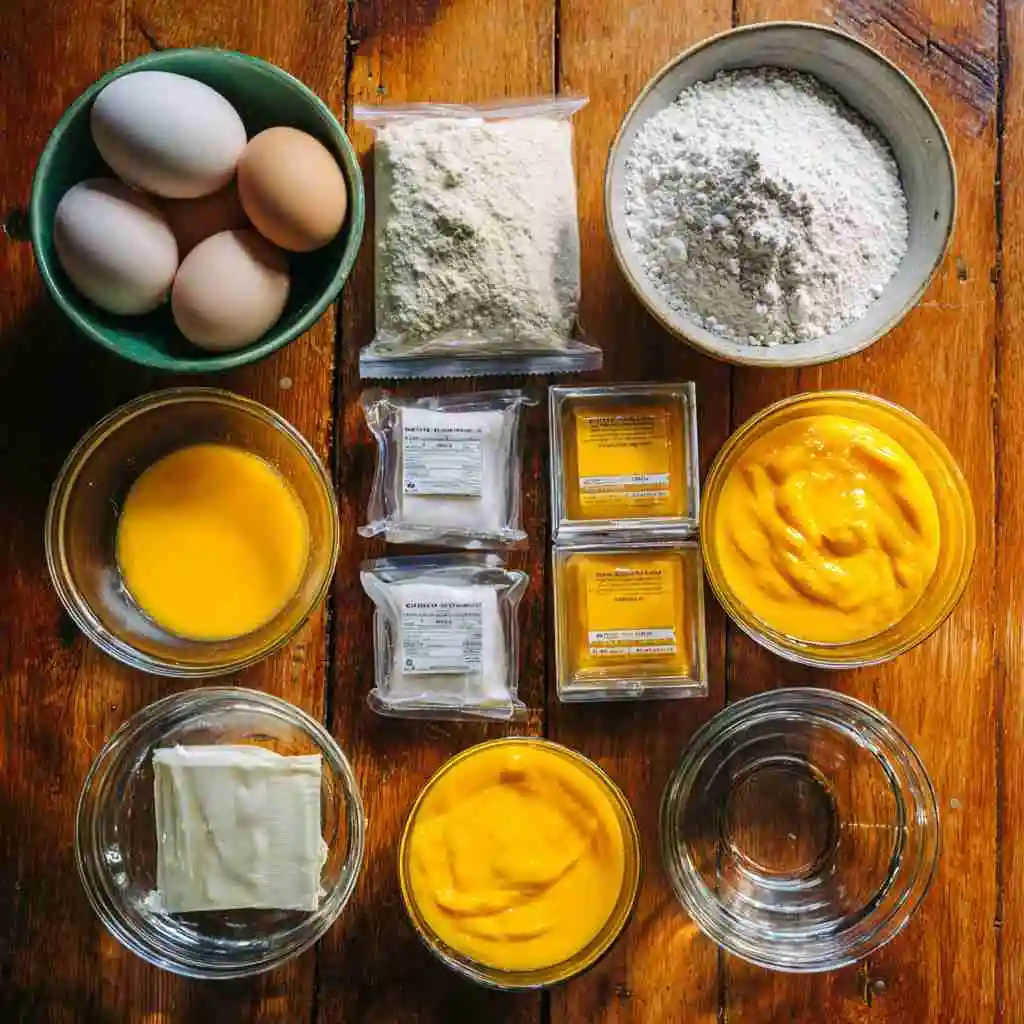
Mango Mousse Cake is a light, creamy dessert that feels like sunshine on a plate. In this article, we’ll share how I fell in love with mango mousse cake, guide you through making a perfect sponge, mousse, and topping, and help you avoid common pitfalls. You’ll also learn smart variations, storage tips, and how to serve it beautifully. Whether you’re a beginner or a seasoned home cook, this mango mousse cake guide will give you confidence and enjoyment from first whisk to final spoon.
Table of Contents

Mango Mousse Cake Recipe – Smooth, Fresh & Simple to Make
- Total Time: 40 minutes
- Yield: 8 servings 1x
Description
A light and creamy mango mousse cake made with a soft sponge base, smooth mousse filling, and a shiny mango gel topping.
Ingredients
3 large eggs at room temperature,
1/2 cup sugar,
1/2 cup all-purpose flour,
1/4 tsp baking powder,
1 and 1/2 cups heavy cream,
3–6 tbsp icing sugar,
2 cups canned mango puree,
1 sachet (7 grams) Knox unflavored gelatin powder,
50 ml water,
1 cup mango puree (for gel topping),
3–6 tbsp sugar (for gel topping),
1 and 1/2 tsp Knox unflavored gelatin powder (for gel topping),
7 tsp water (for gel topping),
1/4 cup water (for stock syrup),
1/3 cup sugar (for stock syrup)
Instructions
Preheat oven to 350°F (175°C). Beat the eggs and sugar until pale and doubled in volume. Gently fold in the flour and baking powder. Pour batter into a greased pan and bake for 18-20 minutes until a toothpick comes out clean. Cool completely.
For the mango mousse, whip the heavy cream with icing sugar until soft peaks form. Bloom gelatin in warm water, dissolve completely, then mix into the mango puree. Let cool slightly before folding in whipped cream gently.
Prepare the stock syrup by heating water and sugar until dissolved. Brush the cooled sponge cake with the syrup to keep it moist.
Pour the mango mousse over the sponge base and refrigerate until set, about 3-4 hours.
For the mango gel topping, bloom gelatin in water, then heat with sugar until dissolved. Mix into mango puree and cool slightly. Pour gently over the set mousse and refrigerate until firm.
Notes
notes for making Mango Mousse Cake:
Use chilled tools when whipping cream to achieve better volume.
Canned mango puree offers consistent results, but ripe fresh mangoes add vibrant flavor when in season.
Gelatin must be fully dissolved and slightly cooled before mixing with whipped cream to prevent clumping.
Don’t skip the syrup—it keeps the sponge moist under the mousse.
Allow each layer to fully set in the fridge before adding the next for clean layers.
- Prep Time: 20 minutes
- Cook Time: 20 minutes
- Category: Dessert
- Cuisine: International
Nutrition
- Serving Size: 1 slice
- Calories: ~320 kcal
- Sugar: 28 g
- Sodium: 85 mg
- Fat: 22 g (13 g saturated)
- Saturated Fat: 13 g
- Unsaturated Fat: 7 g
- Trans Fat: 0 g
- Carbohydrates: 30 g
- Fiber: 2 g
- Protein: 4 g
- Cholesterol: 95 mg
Keywords: mango mousse cake, tropical cake, mousse dessert, Mango puree, heavy cream, icing sugar, baking powder,
The Story & Intro – Mango Mousse Cake Journey
The first time I made mango mousse cake
I can still recall my first attempt at mango mousse cake. I’d tasted something similar at a cozy neighborhood café and couldn’t stop thinking about it. One weekend, I pulled out a can of mango puree, some heavy cream, and gelatin—and decided to give it a go. I didn’t expect much, but the result was better than I’d hoped: a silky mango mousse layered over a light sponge base. I’d accidentally found one of my favorite desserts. Since then, mango mousse cake has become a regular feature in my kitchen—especially during warm months when lighter treats hit the spot.
Why mango mousse cake became a favorite
The thing about mango mousse cake is that it strikes a perfect balance—it’s sweet and creamy without being too heavy. That balance reminds me a bit of the banana bread I used to bake with my mom: simple, heartfelt, and always satisfying. Just like in my Greek Yogurt Jello and Fruit Cocktail Cake Recipe, this cake proves that you don’t need fancy ingredients to make something delicious. With canned mango, whipped cream, and basic pantry staples, you get a dessert that looks elegant but feels familiar. It’s exactly the kind of recipe I love sharing—unfussy, rewarding, and full of flavor.
Sponge cake base that holds its own
The base of any good mango mousse cake starts with the sponge. You’ll want eggs at room temperature so they whip up fluffy when beaten with sugar. Once that mixture is pale and airy, gently fold in flour and a touch of baking powder. Pour the batter into a prepared cake pan and bake just until it springs back when touched. This style of sponge is light yet firm enough to support the mousse without getting soggy. You’ll see similar techniques in other cakes on my site, like the Jello Yogurt Cake.
Mastering the Mango Mousse Layersh

How to make the perfect mango mousse
Mango mousse relies on a simple trio: ripe mango puree, softly whipped cream, and a touch of gelatin to help it set. Using canned mango puree gives you a smooth, reliable base every time. Whip the heavy cream until soft peaks form, then sweeten it gradually with sifted icing sugar—start with 3 tablespoons and taste as you go.
Meanwhile, dissolve unflavored gelatin in warm water (not boiling), and once it’s fully bloomed, mix it into your mango puree. Let that mixture cool a bit before folding in the whipped cream gently. The result should be airy, smooth, and slightly firm—just enough to hold its shape on the cake.
This mango mousse becomes especially dreamy when it’s set over a chilled sponge. You’ll find similar layering methods in other light dessert recipes like this Yogurt Jello Mousse Cake or the Strawberry Cream Jello—a few of my readers’ favorites.
Creating the glossy mango gel topping
Once your mousse layer is set, it’s time to finish strong with a mango gel topping. Again, use canned mango puree as the base and dissolve gelatin in a small amount of water separately. After the gelatin blooms, gently heat it with sugar until dissolved, then stir into the mango puree.
Let it cool slightly—never pour hot liquid onto a chilled mousse or you’ll ruin the texture. Spoon the topping over the mousse, smoothing it out evenly. Then return the entire cake to the fridge until the top is firm and shiny.
This golden layer isn’t just pretty—it adds bold mango flavor and keeps the mousse fresh longer. You’ll see this same logic in chilled desserts like the No-Bake Mango Pie on my site, where fruit and gelatin toppings double as flavor and finish.
Avoiding Common Mango Mousse Cake Mistakes
Easy-to-miss mistakes that can ruin the mousse
Even though mango mousse cake feels easy, it’s surprisingly sensitive to technique. One common mistake is over-whipping the cream. If it turns too stiff, the mousse ends up dense instead of light. Whip the cream just until it holds its shape but still looks smooth and soft—anything firmer can make the mousse feel too heavy.
Another pitfall is rushing the gelatin. If you add it while it’s too warm, it can break the mixture. If it cools too much, it clumps. The trick is to let it reach room temperature before combining with the mango puree. Then, fold gently to avoid flattening all the air from your whipped cream.
Chilling is just as important. Each layer—sponge, mousse, and topping—needs time to firm up before you add the next. Otherwise, layers blur and collapse. It’s tempting to rush, but patience leads to that perfect, clean finish.
What to do when your cake doesn’t go to plan
If your mousse is too delicate to cut cleanly, don’t worry or throw it away. You can still scoop it into glasses and turn it into a layered dessert. Add fruit or whipped cream on top, and it becomes a no-fuss mango parfait.
Cracks or uneven topping can happen if you pour the mango gel while it’s still warm or if the mousse below wasn’t fully set. To fix it, let the topping cool slightly next time, and chill the mousse longer. For quick recovery, cover the top with fresh fruit slices or whipped cream—most guests will never know the difference.
Mango Mousse Cake Variations and Storage Tips

Delicious variations to try at home
Mango mousse cake is incredibly versatile, so feel free to customize it to your taste. One popular variation is adding fresh mango chunks inside the mousse for bursts of texture. Using fresh mangoes instead of canned puree during mango season can boost the cake’s natural sweetness and flavor.
For an extra flavor twist, incorporate coconut milk into the mousse to create a tropical vibe. Another option is to layer the cake with passion fruit gel or sprinkle toasted nuts on top for crunch. If you like, add a thin layer of cream cheese frosting underneath the mousse for a tangy contrast.
No matter which variation you try, keep the core technique consistent: light sponge, smooth mango mousse, and a glossy topping. This flexibility makes mango mousse cake a crowd-pleaser at any occasion.
How to store mango mousse cake for freshness
Proper storage preserves the cake’s texture and flavor. Keep mango mousse cake refrigerated in an airtight container or covered tightly with plastic wrap. You can expect the cake to remain fresh for three to four days when stored properly.
Avoid leaving it out at room temperature for more than two hours, as the mousse contains dairy and gelatin which can spoil. If you need to store it longer, freeze individual slices wrapped well in plastic and foil. Thaw in the fridge overnight before serving.
When ready to serve, let the cake sit at room temperature for about 15 minutes to soften slightly. This will bring out the best flavors and creamy texture.
Conclusion
Mango mousse cake is a delightful dessert that balances lightness and rich tropical flavor perfectly. From baking a simple sponge to mastering the airy mango mousse and glossy topping, this cake offers a satisfying challenge that’s worth every step. By avoiding common mistakes and experimenting with variations, you can make this recipe your own signature treat. Proper storage ensures your cake stays fresh and delicious for days, making it perfect for any celebration or everyday indulgence. Whether you’re new to baking or an experienced cook, mango mousse cake is a sweet way to bring a taste of sunshine to your table.
For more recipes follow me in Facebook
Frequently Asked Questions About Mango Mousse Cake
What are the ingredients for mango mousse cake?
Mango mousse cake requires a few simple ingredients: eggs, sugar, flour, and baking powder for the sponge base; heavy cream, canned mango puree, gelatin, and icing sugar for the mousse; and additional mango puree, sugar, and gelatin for the gel topping. A light syrup made of water and sugar helps keep the sponge moist. These ingredients combine to create a dessert that’s light, creamy, and bursting with mango flavor.
What are some common mistakes when making mango mousse cake?
Common errors include over-whipping the cream, which can make the mousse heavy, and adding gelatin while it’s too hot or too cold, causing clumps or separation. Another mistake is rushing the chilling process; each layer needs enough time to set firmly to avoid a soggy or collapsing cake. Folding the mousse too aggressively can also deflate the mixture, resulting in a dense texture.
What are the different variations of mango mousse cake?
You can customize mango mousse cake by adding fresh mango pieces inside the mousse or swapping canned mango puree for fresh mangoes when available. Incorporating coconut milk into the mousse or layering with passion fruit gel creates tropical flavor twists. Adding toasted nuts or cream cheese frosting layers can introduce texture and richness, making the dessert more complex and appealing.
What is the shelf life of mango mousse cake?
When stored properly in an airtight container in the refrigerator, mango mousse cake stays fresh for three to four days. Avoid leaving it at room temperature for more than two hours because the dairy and gelatin ingredients can spoil quickly. For longer storage, freeze individual slices wrapped tightly and thaw them in the fridge before serving.
Recipes of The Same Type
